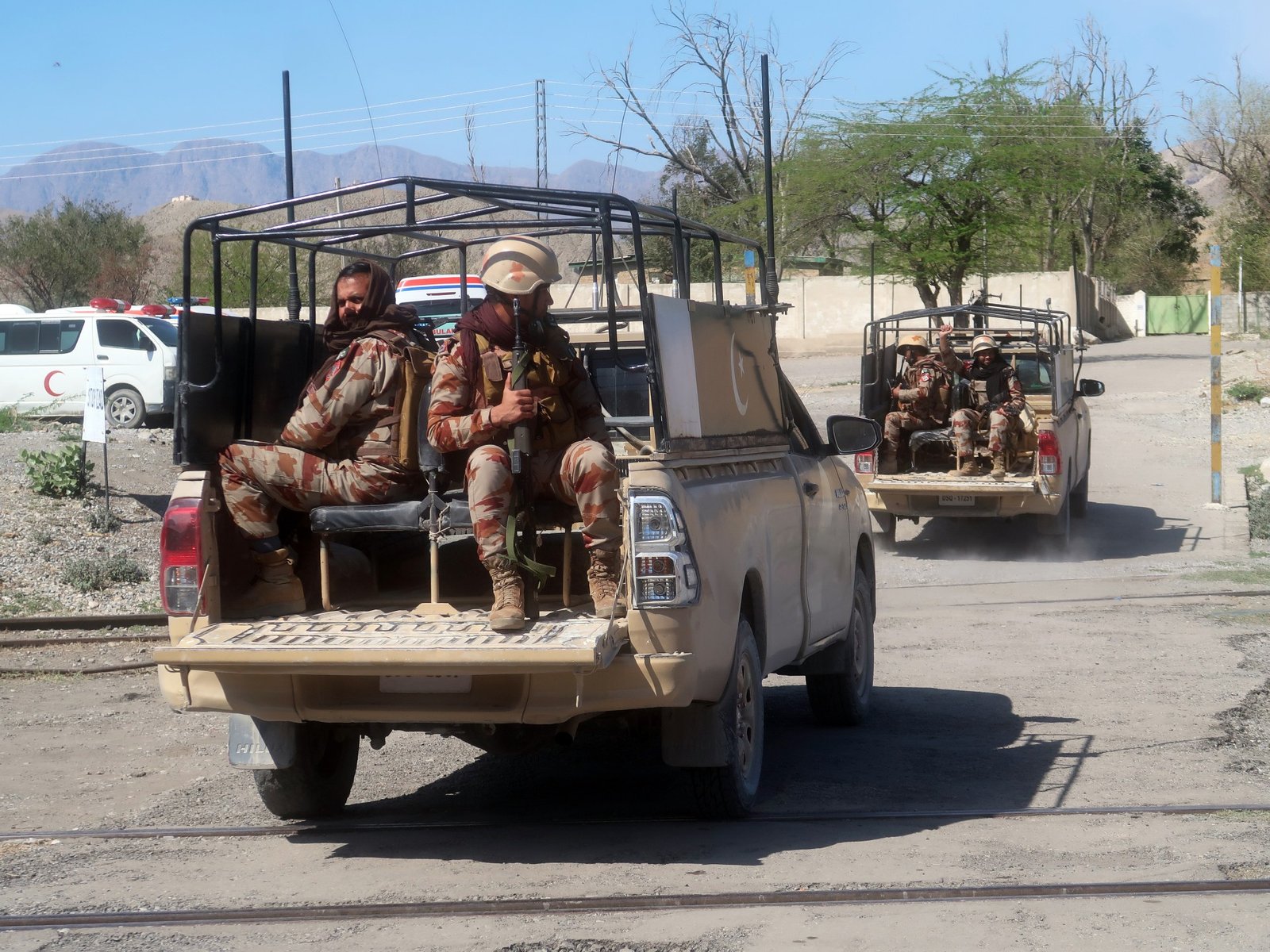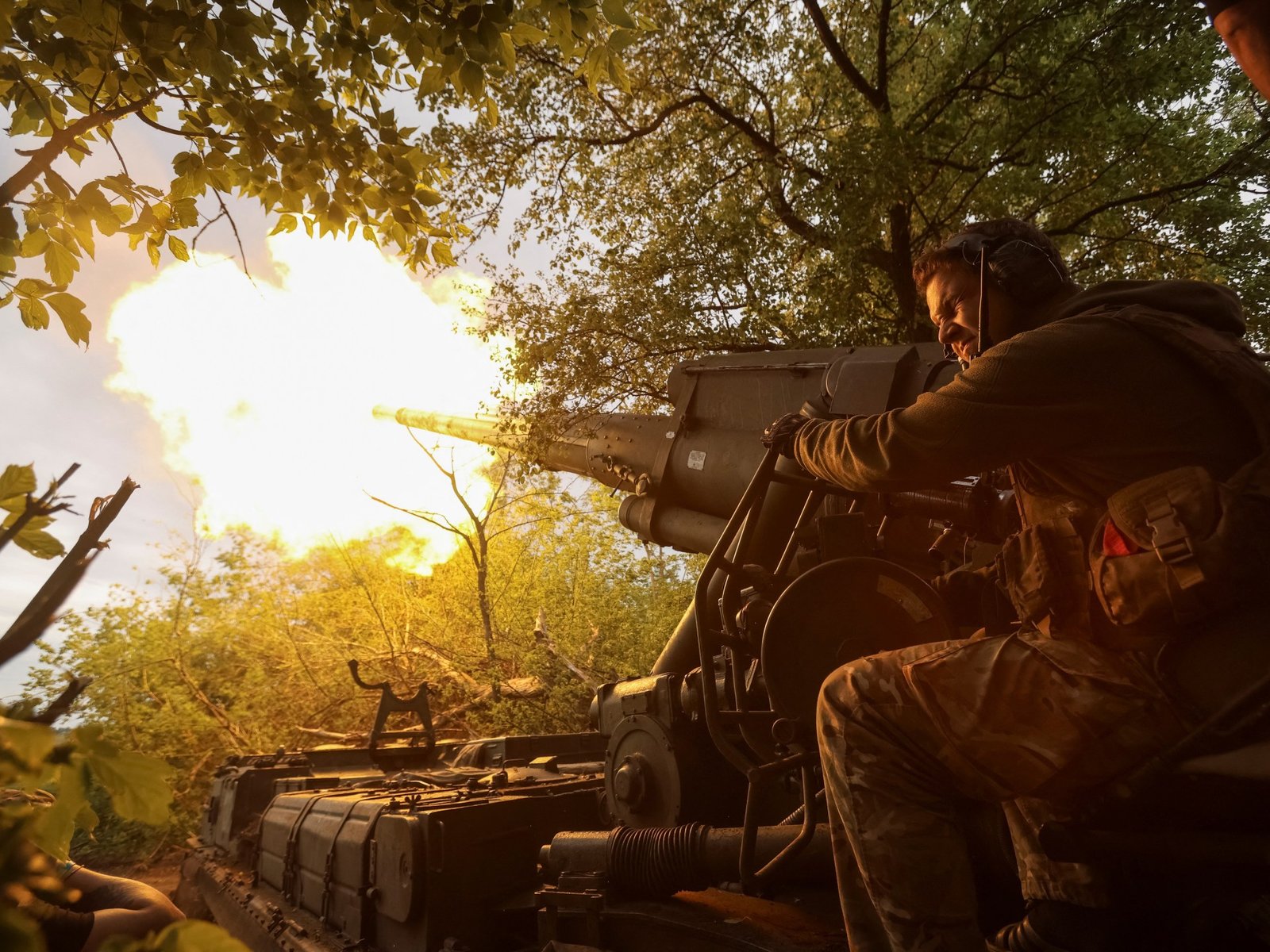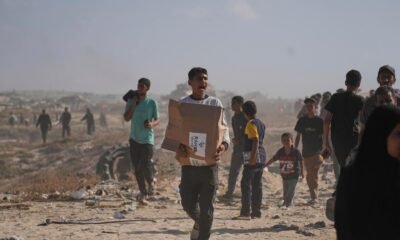Conflict Zones
Pakistan links train hijacking to ‘Afghan handlers’ and Indian mastermind | Conflict News

Islamabad, Pakistan – Pakistan on Friday claimed that the hijacking of the Jaffar Express train earlier this week was carried out by “terrorists” who were communicating with “handlers in Afghanistan”, while alleging that India was the mastermind behind it.
“We must understand that in this terrorist incident in Balochistan, and others before, the main sponsor is eastern neighbour [India],” Lieutenant General Ahmed Sharif Chaudhry, the director general for the military’s media wing Inter-Services Public Relations (ISPR), said during a news conference in Islamabad.
Chaudhry also referred to the media coverage carried out by Indian mainstream channels, which relied on videos shared by the Baloch Liberation Army (BLA), the separatist group responsible for the attack, and accused them of using images generated by artificial intelligence or old incidents.
During the briefing which lasted more than an hour, Chaudhry, along with Balochistan’s Chief Minister Sarfraz Bugti, offered some details of the military operation — named Operation Green Bolan — that culminated in the release of hundreds of passengers from the train following a 36-hour standoff that began on March 11.
According to Chaudhry, a total of 354 passengers were rescued, while 26 passengers and security officials were killed. In addition, 33 fighters belonging to the BLA were also killed.
While the military had earlier said that 21 civilians or security personnel had been killed, Chaudhry stated that as security officials cleared the area, more injured individuals were found, some of whom later died.
Of the 26 killed, 18 belonged to the army or paramilitary forces, three were railway staff members and five were civilian passengers.
‘Aerial Units’ for reconnaissance
Chaudhry said that four hours after the train had departed from Quetta, the BLA attackers intercepted the train 32km (20 miles) from Sibbi city, just before it entered a tunnel in the Bolan Pass region, known for its rugged, mountainous landscape.
“The BLA terrorists intercepted the train using an improvised explosive device. Before that, they began their raid in large numbers and encountered a paramilitary checkpoint, eliminating three soldiers there. Once the train was stopped, they kept the women and children inside while taking the men outside as hostages,” he said.
“As soon as the incident happened, we activated our response teams and started to monitor the situation while maintaining an appropriate distance,” Chaudhry said.
While Chaudhry did not disclose specifics, visual evidence from the briefing indicated that the Pakistani military relied heavily on drones to monitor the situation.
Intelligence sources also confirmed that reconnaissance teams and aerial units were deployed within an hour of the train being stopped.
The general said that the BLA segregated passengers based on ethnicity, a fact that was confirmed to Al Jazeera by survivors, as well.
“They divided people into smaller groups based on ethnicity. While a large number of BLA fighters moved away to their hideouts in the mountain, a smaller group remained with the hostages,” he said. Many of the fighters who remained at the site “were suicide bombers,” he added.
Chaudhry stated that intelligence monitoring revealed the abductors were using walkie-talkies to allegedly communicate with their “handlers in Afghanistan.”

How did the operation unfold?
The military said that on the night of March 11, more than eight hours after the hijacking, a group of women, children, and elderly passengers were released, who walked to the nearest train station, 6km (four miles) away.
Intelligence monitoring by security agencies at the time suggested the potential presence of suicide bombers among the hostages. On the morning of March 12, Chaudhry said, military snipers killed several BLA fighters, enabling some hostages to escape amid the chaos.
The main ground operation was then prepared, to be led by the Zarrar Company, an elite unit of the Army’s Special Services Group (SSG), which specialises in operations against armed groups.
“It is a highly trained unit uniquely equipped for counterterrorism situations, including hostage crises. The company commander is a major-ranked officer,” an intelligence source said.
Showing a video clip, Chaudhry noted that as the operation commenced, many hostages sitting outside the train ran for safety.
“By midday on March 12, Zarrar Company had completed its situational assessment. Tracking BLA communications revealed potential suicide bombers were stationed near the hostages. They were eliminated first, after which the troops made their way inside the train,” the general added.
“It demonstrates the professionalism and competence of our troops that there was not a single hostage casualty during the rescue operation,” he said.
All the fighters were killed. Security officials told Al Jazeera that they could not capture anyone alive due to the nature of the operation.
“As a matter of policy, capturing insurgents remains important to our doctrine, but a hostage situation offers little room for that. If you want to rescue the hostages, actions must be precise and surgical,” a security official said, requesting anonymity as he was not authorised to speak to the media.
How have India and Afghanistan responded?
Following the news conference, neither India nor Afghanistan issued an immediate response.
However, earlier on Friday, officials from both countries strongly reacted to Pakistan’s Ministry of Foreign Affairs statement on Thursday, which also blamed both nations.
“India has been involved in terrorism in Pakistan. In the attack on Jaffar Express, the terrorists were in contact with their handlers and ring leaders in Afghanistan,” Pakistan’s Foreign Ministry spokesperson Shafqat Ali Khan said during his weekly news briefing in Islamabad yesterday.
Khan added that intercepted communications confirmed links between the attackers and Afghanistan.
“The terrorists have safe havens in Afghanistan, and Pakistan has repeatedly urged the Afghan interim government to prevent groups like the BLA from using its soil for terrorism,” he said.
The Indian government categorically rejected Pakistan’s allegations.
“We reject the baseless accusations made by Pakistan. The whole world knows where the epicentre of global terrorism is. Pakistan should look within itself instead of blaming others for its internal problems and failures,” Indian Ministry of Foreign Affairs spokesperson Randhir Jaiswal said in a statement on Friday.
Afghanistan also denied any connection between the attackers and its territory.
“Pakistan should focus on its security and resolving its internal issues instead of making irresponsible statements,” a statement from Kabul read.
The Taliban-led government’s Ministry of Foreign Affairs spokesperson Abdul Qahar Balkhi also urged Pakistan on social media to “focus on resolving its security and internal issues instead of making such irresponsible comments”.
Balkhi also claimed that no BLA members were present in Afghanistan and denied any connection between the group and Afghanistan.
Last month, a United Nations report stated that the Afghan Taliban, in power since August 2021, provides support to the Pakistan Taliban (Tehreek-e-Taliban Pakistan or TTP), which has carried out multiple attacks in Pakistan.
It further said that the BLA reportedly has ties with both the Pakistan Taliban and the ISIL affiliate in Khorasan Province (ISKP), indicating a broader convergence of armed groups with distinct, but intersecting agendas.
Conflict Zones
Ballet helps fight war fatigue in Ukraine’s front-line Kharkiv city | Russia-Ukraine war

In the Ukrainian city of Kharkiv, escaping the war with Russia is nearly impossible.
On certain days, when the wind shifts, residents of this historic city can hear the distant rumble of artillery fire from the front line, some 30km (18.5 miles) away.
Most nights, Russian kamikaze drones packed with explosives buzz overhead as parents put their children to bed.
Three years since Russia’s invasion of Ukraine, the unrelenting war exerts a heavy psychological burden on many in Kharkiv. Yet, there is a place in the city where, for a few fleeting hours, the war seems to vanish.
Beneath the Kharkiv National Academic Opera and Ballet Theatre, in a dim, brick-walled basement, a dance company has established a refuge from drones and bombs – a space where audiences can lose themselves in performances of classic ballets.
In April, this underground venue hosted performances of Chopiniana, an early 20th-century ballet set to the music of Frederic Chopin. Despite the improvised setting, the ballet was staged with full classical grandeur, complete with corps de ballet and orchestra.

It marked a significant milestone for Kharkiv’s cultural life: the first complete classical ballet performance in the city since February 2022, when Russian troops launched their invasion of Ukraine.
“In spite of everything – the fact that bombs are flying, drones, and everything else – we can give a gift of something wonderful to people,” said Antonina Radiievska, artistic director of Opera East, the ballet company behind the production.
“They can come and, even if it’s just for an hour or two, completely immerse themselves in a different world.”
Despite Ukraine’s rich tradition in classical ballet, the art form now seems far removed from the everyday existence of Ukrainians living through war. Daily routines revolve around monitoring apps for drone alerts, sleeping on metro station floors to escape air raids, or seeking news of loved ones on the front line. Pirouettes, pas de deux and chiffon tutus feel worlds away.
Nevertheless, the journey of Kharkiv’s ballet through wartime reflects the ways in which Ukrainian society has adapted and evolved.
On February 23, 2022, the National Academic Opera and Ballet Theatre staged a performance of the ballet Giselle. The next day, Russia launched its full-scale invasion. As Moscow’s forces advanced towards Kharkiv and threatened to seize the city, the theatre closed its doors and much of the ballet troupe departed.
Some regrouped in Slovakia and Lithuania, mounting ballet productions abroad with assistance from European sponsors.

By 2023, although the conflict ground on, the situation in Kharkiv, in Ukraine’s northeast, had stabilised after Russian ground troops withdrew. A new realisation took hold – this was a long-term reality. Locals began referring to the city, and themselves, with the Ukrainian word “nezlamniy”, meaning invincible.
That year, work began on transforming the theatre’s basement into a performance venue. By October 2023, it was being used for rehearsals. The following spring, authorities permitted the theatre to admit audiences, and small-scale ballet performances, including children’s concerts, resumed.
The revival of Chopiniana marked the next chapter in Kharkiv’s wartime cultural journey.
Staging a classical opera again signals that Ukraine endures, says Igor Tuluzov, director-general of Opera East. “We are demonstrating to the world that we really are a self-sufficient state, independent, in all its aspects, including cultural independence,” he said.
The auditorium now seats 400 people on stackable chairs, compared with the 1,750 seats in the main theatre above, where the plush mustard seats remain empty.
The stage is a quarter the size of the main one. Grey-painted bricks, concrete floors, and exposed pipes and wiring form a stark contrast to the varnished hardwood and marble of the theatre above. The basement’s acoustics, performers say, fall short of the cavernous main auditorium.
For artistic director Radiievska, however, the most important thing is that, after a long pause, she and her troupe can once again perform for a live audience.
“It means, you know, life,” she said. “An artist cannot exist without the stage, without creativity, without dance or song. It’s like a rebirth.”
Conflict Zones
Sudan Paramilitary Claims Key Gains in Kordofan; Fighting Intensifies Near Khartoum

Khartoum, May 30, 2025 — Rapid Support Forces (RSF) deputy leader Abdel Rahim Daglo announced on Friday that RSF fighters would press their eastward advance toward Khartoum, claiming “great victories” in several strategic towns across Kordofan. Addressing troops at an undisclosed location, Daglo said that all armed groups within the Tasis coalition had joined his paramilitary ranks and were now operating in concert with the RSF.
According to Daglo, RSF units seized control of Al-Dubaibat and Al-Hammadi in South Kordofan state, as well as Al-Khawi in neighboring West Kordofan. “Our fighters have secured these areas after intense clashes with Sudanese Armed Forces (SAF) units and allied militias,” Daglo declared, adding that the momentum would not wane until the capital was within reach.
Sudan’s army, however, downplayed recent RSF advances as part of a “reorganization” campaign. A senior ally of the SAF—also the governor of Darfur—insisted that the military was regrouping and fortified its positions to counter what he described as “a temporary setback.” He maintained that the SAF’s strategic reserves remained intact and that front-line forces were being repositioned to mount a sustained defense of Khartoum.
As fighting has spread northward, the humanitarian situation in Khartoum has deteriorated sharply. With basic services all but collapsed, a deadly cholera outbreak has emerged in the densely populated capital. Aid agencies warn that the impending rainy season could exacerbate sanitation challenges, fueling further disease transmission. The United Nations has labeled the crisis “the world’s worst humanitarian emergency,” citing over 25,000 confirmed deaths and more than 3 million internally displaced persons since April.
International pressure has also mounted on Sudan’s transitional government. In late May, Washington imposed sanctions on Sudanese military leaders for the “alleged use of chemical weapons” against civilians. In response, the government announced a national investigation into the claims—a move it said was aimed at preserving Sudan’s international standing amid intensifying conflict.
With both sides entrenching their positions around Khartoum, observers warn that a protracted stalemate could unleash further civilian suffering. The RSF’s pledge to advance eastward has raised concerns that front-line engagements may spill into densely populated suburbs, where millions have already endured weeks of intermittent shelling and aerial bombardments. For now, the fate of Khartoum—and the broader prospects for peace—remain uncertain as paramilitary and army forces brace for a decisive showdown.
Conflict Zones
Two killed in Russian attacks on Ukraine before possible talks in Turkiye | Russia-Ukraine war News

Russia has confirmed it will send a delegation to Istanbul, but Kyiv has not yet accepted the proposal.
Russian drone and missile attacks on Ukraine have killed at least two people, according to officials, as Ukraine ordered the evacuation of 11 more villages in its Sumy region bordering Russia.
Russian troops launched an estimated 109 drones and five missiles across Ukraine on Friday and overnight, the Ukrainian air force said on Saturday, adding that three of the missiles and 42 drones were destroyed and another 30 drones failed to reach their targets without causing damage.
The attacks came amid uncertainty over whether Kyiv will take part in a new round of peace talks early next week in Istanbul.
In the Russian attacks on Saturday, a child was killed in a strike on the front-line village of Dolynka in the Zaporizhia region, and another was injured, Zaporizhia’s Governor Ivan Fedorov said.
“One house was destroyed. The shockwave from the blast also damaged several other houses, cars, and outbuildings,” Fedorov wrote on Telegram.
A man was also killed by Russian shelling in Ukraine’s Kherson region, Governor Oleksandr Prokudin wrote on Telegram.
Moscow did not comment on either attack.
Meanwhile, authorities in Ukraine’s Sumy region said they were evacuating 11 villages within a roughly 30-kilometre (19-mile) range from the Russian border.
“The decision was made in view of the constant threat to civilian life as a result of shelling of border communities,” the regional administration said on social media.
Ukrainian President Volodymyr Zelenskyy has said some 50,000 Russian troops have amassed in the area with the intention of launching an offensive to carve out a buffer zone inside Ukrainian territory.
Ukraine’s top army chief, Oleksandr Syrskii, said on Saturday that Russian forces were focusing their main offensive efforts on Pokrovsk, Torets and Lyman in the Donetsk region, as well as the Sumy border area.
Syrskii added that Ukrainian forces are still holding territory in Russia’s Kursk region – a statement Moscow has repeatedly denied.
The evacuations and attacks came just two days before a possible meeting between Kyiv and Moscow in Istanbul, as Washington called on both countries to end the three-year war.
Russia has confirmed it will send a delegation, but Kyiv has not yet accepted the proposal, warning the talks would not yield results unless the Kremlin provided its peace terms in advance.
Zelenskyy said Saturday it was still not clear what Moscow was planning to achieve at the meeting and that so far, it did not “look very serious”.
-

 Africa4 days ago
Africa4 days agoSurvivor of Liverpool car ramming talks of shock and panic
-

 Sports3 days ago
Sports3 days agoThe Knicks are bringing hope and title dreams back to New York after years in the doldrums
-

 Lifestyle3 days ago
Lifestyle3 days agoChildren and careers: Talking to kids about what they want to be when they grow up
-

 Lifestyle4 days ago
Lifestyle4 days agoHow to decorate a patio, balcony or other small outdoor space
-

 Lifestyle4 days ago
Lifestyle4 days agoFaizan Zaki hopes to go from spelling bee runner-up to champ
-

 Middle East5 days ago
Middle East5 days agoHajj pilgrimage in Saudi Arabia to begin on June 4 | Religion News
-

 Middle East4 days ago
Middle East4 days agoGaza’s aid system isn’t broken. It’s working exactly as designed | Humanitarian Crises
-

 Europe5 days ago
Europe5 days agoMacron’s marital shove disappears from French airwaves




